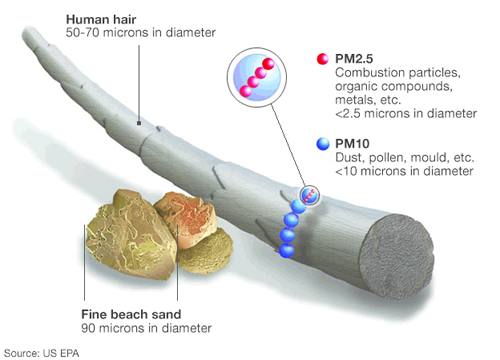Diesel is the dominant fuel used by the commercial transportation sector. Diesel engines offer fuel economy, power and durability. In the United States approximately 80 percent of all freight is moved by diesel engines. Diesel engines also power most non-road equipment as used in the construction, agricultural, marine and locomotive sectors. While the operational advantages of diesel are clear, diesel engines emit large amounts of nitrogen oxides, particulate matter, and toxic air pollutants.
Diesel soot

Diesel exhaust contains dozens of toxic substances but one of the leading concerns is the particulate matter which is toxic and very small in size at less than 2.5 microns. A typical human hair is 70 microns. The small size makes it highly breathable to the deepest part of the lungs. These ultra-fine particles are also known to attract other toxic substances in the air increasing toxicity.
Diesel exhaust increases cancer risk
Diesel particulate matter is linked to a number of serious public health problems including aggravating asthma, heart and lung disease, cancer and premature mortality. In June 2012, the International Association for Research on Cancer classified diesel exhaust as a known carcinogen to humans. The new classification is based on sufficient evidence that exposure to diesel engine exhaust is associated with increased lung cancer risk. The Environmental Quality Commission established a health-based benchmark based on increased risk for cancer from exposure to diesel in 2006. Oregonians have an increased risk for health effects from diesel emissions at present levels of exposure in everyday life.
Black carbon and climate change
Diesel exhaust also has environmental significance as a global warming contributor due to the black carbon particulate, about 70 percent of the particulate emitted by a diesel engine. Black carbon from all sources has been identified as a potent climate change forcing agent, second only to carbon dioxide. Black carbon has a short impact time in the atmosphere, weeks to months, as compared to carbon dioxide that lasts 50 to 100 years. Control of black carbon offers a significant opportunity for slowing, possibly even reversing climate change. While black carbon results from a variety of combustion processes, diesel engines are the largest source of black carbon in North America.
Clean diesel reduces health costs
Increasingly stringent federal regulations have resulted in the manufacture of what can be truly characterized as clean diesel engines. These regulations, however, only apply to new vehicles and equipment. This means that with the long term durability of existing diesel engines the promise of reduced impacts from exposure to these engines’ exhaust will not be realized for at least twenty years.
EPA estimates that cleaning up the engines as a result of federal regulations will ultimately reduce documented public health and environmental impacts to be worth more than $296 billion annually. In Oregon alone, the direct and indirect public health and environmental impact of exposure to diesel exhaust could be valued up to $3.5 billion per year. This is an indicator of how serious the effects of diesel exhaust exposure can be.